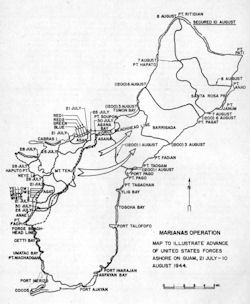
New Guinea--NOEMFOOR
SURPRISE LANDING WITH FEW CASUALTIES
Shortly after dawn on 2 July, 1944 a landing force built
around the 158th U.S. Infantry Regimental Combat Team, reinforced by artillery,
anti-aircraft, tank, engineer, and service units totaling 7,078 men, landed on
Noemfoor Island which lies about 60 miles west of Biak Island. The Japanese had
developed three major airfields on the island, Kornasoren, on the north coast,
Kamiri, 2½ miles to the west; and Namber, seven miles south of Kamiri on the
west coast. Our troops landed at the east end of Kamiri runway and before noon
had captured the entire field. Since we went ashore at points where reefs and
other natural conditions made such operations hazardous, by-passing the enemy's
prepared positions along the beaches, the landing apparently took the enemy by
surprise. We suffered extremely few casualties and before evening had
established a curving beachhead protected on two sides by the sea and on a third
by the Kamiri River. Reinforced by paratroops we advanced toward Kornasoren
airfield on the 3rd, supported by tanks, Naval guns and aircraft, and captured
it on the 4th. Our planes, had spent nearly three weeks softening up the island
by a series of daily raids, climaxed on the day before the landing by a very
heavy attack in which 230 tons of bombs were dropped. Yellow Beach was selected
as the landing point because the coral reef at that point is relatively smooth,
level, and free of deep water areas inside the reef. Deep water on both sides of
the boat lane, inside the reef, limited the lane to a width of 400 yards,
opening to 800 yards at the beach after clearing deep water. The landing plan
provided for landing two battalions abreast in 7 assault waves at three minute
intervals. Assault battalions with amphibian vehicles which were to land them,
were embarked in 8 LST's. The first 3 waves were composed of a total of 39
LVT(2)'s and the following four waves totaled 52 DUKW's. The reserve battalion
embarked in LCI's were to be Landed
in a second trip of the LVT's and DUKW's or, if
practicable, directly on the coral ledge from ramps of the LCI's. The artillery
battalion embarked in LST's, was to be landed ashore by means of DUKW's equipped
with "A" frames. Tanks, tractors, and bulldozers were to be carried forward in
13 LCT's and, beginning with the 8th wave, to be landed across the coral reef.
40 LCM's, carrying shore party personnel, vehicles and supplies, were to remain
in LCM assembly area until called into the beach by the control officer. Either
suitable beaching points would be found for them at the edge of the reef, where,
at low water, vehicles could be discharged across the reef, or they would remain
loaded until demolition parties could blast channels thru the reef. Bulk stores
in LST's were to be unloaded in shuttle trips of amphibious vehicles. Seizure of
the three fields on Noemfoor Island gave us seven air bases at the mouth of
Geelvink Bay all within about 800 miles of the Philippines and within bombing
range of important Netherlands East India enemy bases,
COAST GUARD MANNED LST's AT NOEMFOOR
On 2 July, 4 Coast Guard manned LST's, Nos. 18, 66, 67,
and 204, were among those that crept slowly through blue water
toward the patch of green water which indicated the coral reef that extends
entirely around the perimeter of Noemfoor Island. The reef, less than a foot
below the surface of the water at most points, had made for an arduous unloading
operation. On most beaches, LST's can nudge in close enough to shore to
disembark their cargoes directly onto the beach. At Noemfoor, it was necessary
to transfer cargoes to the smaller, shallower draft LCT's which can successfully
drop their ramps on the jagged ends of the reef. Transfer of heavy army
equipment between the ships was a delicate operation requiring the greatest
skill. Coast Guard LST skippers demonstrated the "know-how" gained from months
of amphibious operations in the New Guinea theatre. A Navy LST skipper who was
present at the initial landings described the operation as "mild." One reason
why the Japanese had not made any retaliatory air attacks may have been the
terrific toll of Japanese planes by our carrier task force the week before.
Despite the mild landing, the landing of the paratroopers on July 3rd and 4th
turned out to be as spectacular as anyone could have wished. Dozens of DC4's
came in low over the island and dropped hundreds of paratroopers while above
them A20's and P38's swooped and darted to keep
at bay any prowling zeros. The only casualties were leg and ankle injuries from
the rocky terrain.

